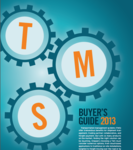Cerasis » Press Releases
July 30, 2013 – 5 Transportation Management System Must Haves & Cerasis Inc's Cerasis Rater TMS Featured as Top TMS in Inbound Logistics' 2013 TMS Buyer's Guide
Looking for a Transportation Management System? We found one. Each year, around May, Inbound Logistics puts together its annual "TMS (Transportation Management System) Buyer's Guide". Transportation management systems (TMS) offer tremendous benefits for shipment management, trading partner collaboration, and freight payment. But with so many products on the market, finding the right solution can be daunting. Shippers choosing a TMS must consider numerous options, from cloud-based applications to traditional on-site installations, targeted to freight moving over the road or by rail, in containers or as parcel shipments. To help you select the best option for your transportation management needs, Inbound Logistics’ TMS Buyer’s Guide offers a best-of-breed shortlist of some leading TMS providers and solutions.
When looking for a good Transportation Management System here are 5 must have features that you should look out for in a solid Transportation Management System
The ability to track and manage carrier contracts
Part of what makes carrier selection and rate comparison so complex is the wide variation in carrier contract terms—particularly when it comes to accessorial charges (for example, fees for the use of lift gates or "lumpers," temporary workers who assist with freight loading or unloading). A single customer will have many different lanes they ship in and it's important for a robust TMS system to support multiple carriers with rates maintained in the system and built in from the get go of the TMS implementation.
The ability to handle freight settlement
The logistics manager's job doesn't end once the freight has been loaded onto the vehicle. There are still invoices to be reconciled and bills to be paid at the end of the cycle. To streamline the process, choose a TMS that can audit and pay freight invoices.
Essentially, the system takes invoices as they come in and matches them to loads in the system. It then compares the rated amounts to invoiced amounts based on established rules. Once the invoices are approved, the software applies the necessary general ledger codes to the trucking charges to ensure proper accounting. Additionally see if someone manually audits them as well, as this is a nice added service from a logistics provider to see if the amounts can be corrected with the carrier or absorbed.
The ability to provide item visibility
When it comes to the whereabouts of their freight, today's customers are no longer satisfied with assurances that the shipment is en route. They expect their suppliers to be able to pinpoint the exact location of their freight at any given moment. In today's TMS platforms, especially with the ability to integrate via EDI with a carrier, auto pick up and automatic notifications should be standard.
The ability to provide business intelligence
In addition to processing routine freight shipping tasks, more and more TMS these days have the capability to analyze the user's shipping practices and identify opportunities for improvement. They do this by capturing data and using it to develop key performance indicators (KPIs)—metrics showing how an operation is performing in areas like on-time delivery or damage in transit.
These kinds of embedded analytics can provide valuable information for tasks like carrier selection. For instance, a shipper could use the KPIs to create a carrier scorecard, which it then might use to handicap the carriers. If the scorecard showed that a particular carrier offered the lowest rates but had a poor record of on-time delivery, the shipper would automatically know to divert a particularly time-sensitive shipment to a slightly higher-cost carrier with a better service record.
Integrated Freight Management Services
Technology solutions are great for scale, business decisions from data, and of course automation which decreases costly data entry errors, but a technology solution is typically not the end all be all. When implementing a TMS, make sure you also ask about further logistics services such as Freight claims, dedicated customer service reps, and an account manager who can work with you over time to continue driving down costs in your logistics department.
This year for the first time in the 16 year history, we were fortunate enough to have been included in the Inbound Logistics "2013 TMS Buyer's Guide" .

Click to Enlarge
Posted 7/30/13 at 6:36pm by Cerasis